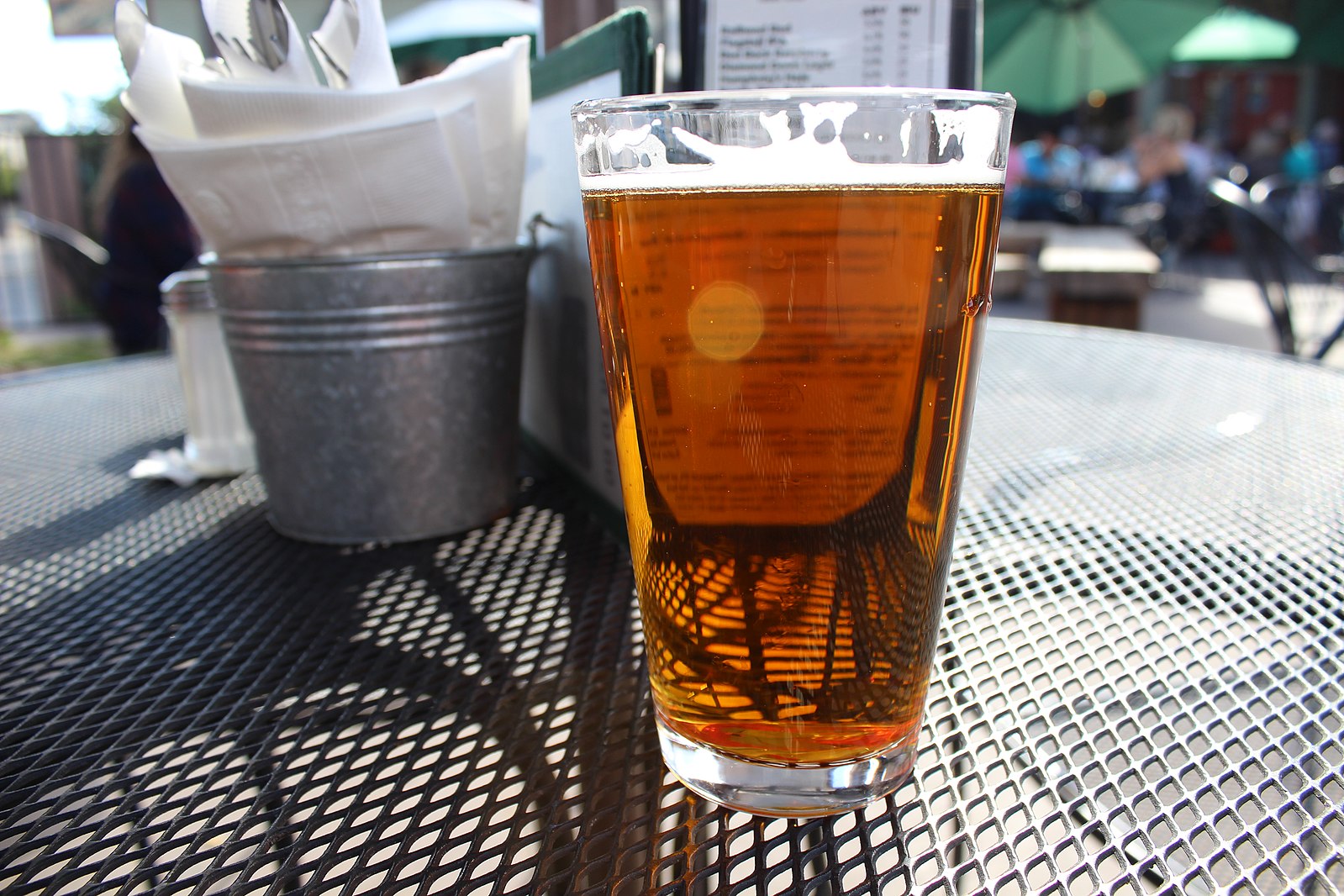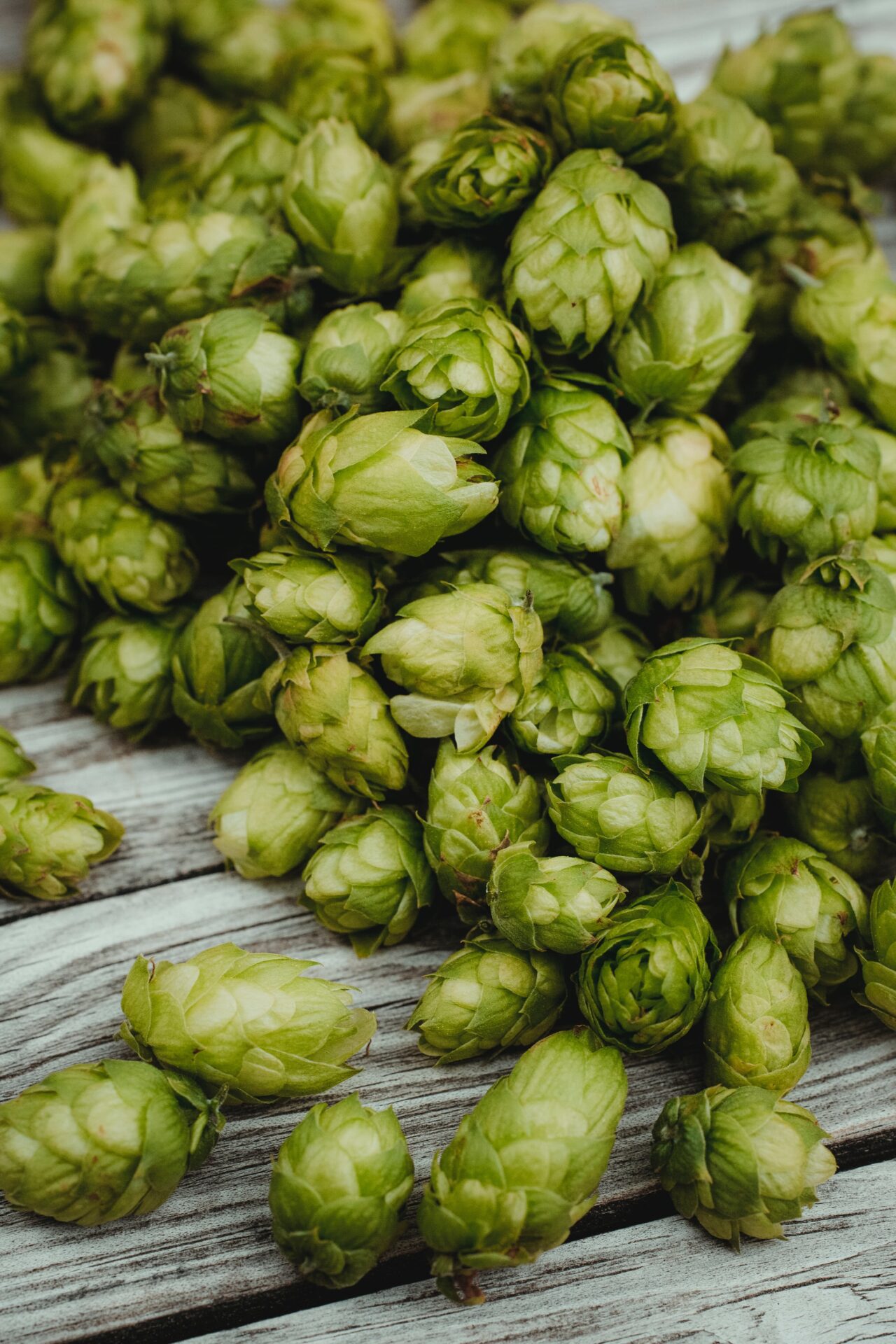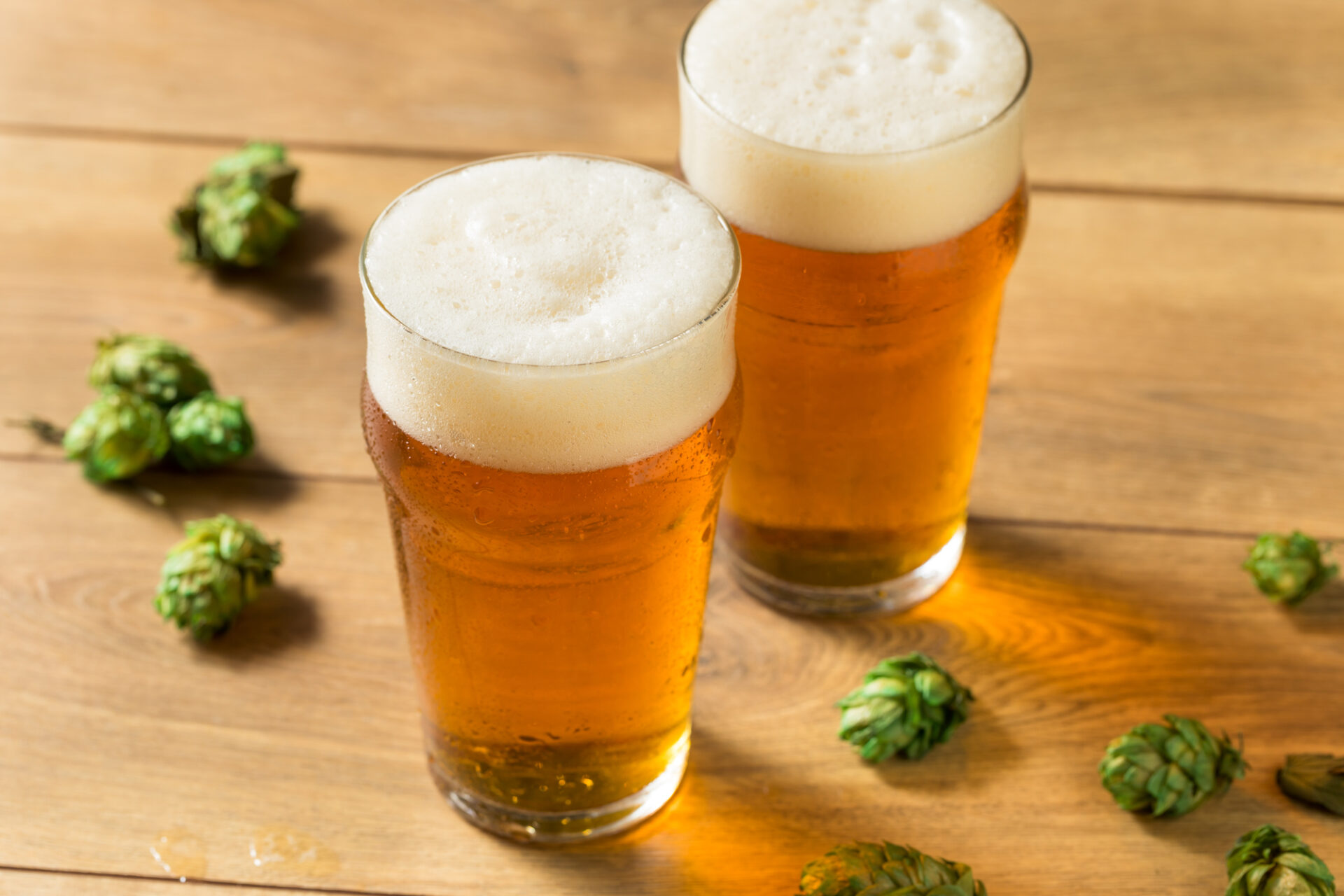Just like most things in life, when brewing beer keeping it simple can often be best.
The more ambitious homebrewers may often like to attempt something more complex like a Belgian-style ale, an over-hopped IPA, or even a specialized seasonal beer like an Oktoberfest. But I always think a good test of your homebrewing skills is making a decent American Pale Ale.
As a beer style, American Pale Ales are often forgotten about or overlooked. IPAs, Porters, Stouts, or European-style specialty beers may seem more adventurous, but the American Pale Ale style allows for much more creativity.
Closely related to the English Pale Ale, an American Pale Ale, or APA, tends to use more American-orientated ingredients and be a more hop-forward ale than the malty styles of the UK.
It will be slightly darker in color than a Blonde beer but still golden to amber, anything lighter than brown, to be honest. And although it will be hoppier than its British counterparts, it shouldn’t be as bitter as an IPA and also should have a more approachable alcohol content.
Basically, an American Pale Ale should be very drinkable. Not a beer you sip like some of the stronger ales or barley wine styles of beer, but one you can consume pint after pint of. A session beer for us hopheads.
The original hoppy beer, the American Pale Ale is often credited as the beer which kickstarted the American craft beer revolution.
If it hadn’t been for brewers like Fritz Maytag at Anchor Brewing (the first American craft beer Liberty Ale), Jack McAuliffe of the short-lived New Albion Brewery (New Albion Ale), or Ken Grossman of Sierra Nevada (the era-defining Sierra Nevada Pale Ale) we may not have the hoppy craft beers we enjoy today.
Brewing Tips for an American Pale Ale

American Pale Ales are all about that dreaded word “balance”. Mistakes many homebrewers make when first attempting to brew an American Pale Ale are giving the beer excessive body, too much sweetness, or a lingering harshness. All three of these factors can affect the drinkability of the finished beer.
The body should be medium at the most (medium-light is preferred), the finish should be relatively dry (a moderately malty backbone defines an APA but there shouldn’t be too much residual sugar) and the alcohol shouldn’t be too noticeable.
Harshness is another matter, with beers that use a lot of hops commonly exhibiting harsher flavors. This can be down to the number of hops used, the amount of boil time for the hops, the water chemistry, and the alpha acid content of the hops.
Larger amounts of hops will often give vegetal flavors while longer boils can lead to extracting harsh compounds. Brewing water that has a higher pH, a high residual level of alkalinity, or high sulphate content can also add to the harshness of the hops and the finished beer.
It’s always recommended with a hoppy beer like a Pale Ale to use carbon-filtered or reverse-osmosis water for that clean crisp finish. Treating your strike water with camped tablets or adding a little calcium chloride or phosphoric acid can ensure the mineral makeup of the water is just right.
Follow these other tips to perfect your American Pale Ale brew.
Grain Bill
With an American Pale Ale, the grain bill is fairly simple – less variety is better with this style. Don’t try adding every type of specialty malt you can get your hands on.
The majority of the grain bill should consist of some sort of American pale malt, typically domestic 2-row. Some brewers may also use an English Pale Ale malt (Crisp Maris Otter is always a good choice) although sometimes a Belgian Pale malt like Dingemans can also feature.
Your main pale malt should make up about 90% of the total grain bill with the other 10% allowing for some experimentation. Keep it simple though. Crystal malt is generally used for about 5 to 10% of the total grist with a color rating of 40ºL or lower working best.
Darker crystal malts can affect the color or flavor too much of the beer, and overuse can make the beer too sweet or have too much body.
Malts such as Munich, Vienna, or caramel malt could be used to give the beer more maltiness but ensure you keep it below 10% of the grist or your beer could end up more like a traditional British bitter.
Biscuit or Victory malt can add some breadiness but should be limited to half a pound in a five-gallon batch.
Most all-grain brewers will add a small percentage (approx 5%) of wheat or sugar to their grain bill which can help with head retention and/or the sugar adds a slight drying effect to the fermented beer.
The Hops

The distinguishing difference between an English Pale and the American version is the hops used. This style should show off the bitterness, flavor, and aroma of the American hops.
American Pale Ales have a rather higher bettering rate than their English counterparts but shouldn’t reach too close to the level of an IPA. Most West Coast Pale Ales will have IBUs of over 40, sometimes approaching 60 or 70 in extreme cases (bordering on session IPA), but a classic American Pale Ale should have an average of between 25 – 40 IBUs.
Almost exclusively all American varieties of hops are used, the classic “C” hops of Chinook, Cascade, Columbus, and Centennial are usually showcased in most commercial examples of an American Pale Ale.
Many of the Pale Ales of the Pacific Northwest and Northern California feature this strong citrussy, piney flavor of hop but more modern hop additions include Citra, Amarillo, Simcoe, Ahtanum, and Glacier.
One of my favorite combinations is the simple Centennial and Cascade hops blend although Amarillo and Simcoe tend to work just as well. Try to keep it simple, preferably less than 4 hop additions, with even just one hop type used making this a great single-hop varietal beer.
Just be careful if using several hops so that their aromas and flavors don’t clash. A simple 60-minute addition for bettering and flavor hops added 10 – 15 minutes before the end of the boil will normally suffice. Aroma hops should be added just before or at flame out.
A good hopping schedule for an American Pale Ale boil would be:
- 1 oz for bittering at the 60-minute stage
- 0.5 oz to 1 oz for flavoring hops at 15 – 20 minutes
- 0.5 oz to 1 0z for aroma at 1-2 minutes or flame out.
Dry hopping can also give the beer some additional hop aroma, although be warned it can often impart grassy notes or vegetal matter that some drinkers may not like too much.
Yeast
The yeast selection for an American pale is pretty straightforward. You will need a clean, neutral American strain that attenuates well.
The most popular choice as made famous by the Sierra Nevada Pale Ale is the “Chico” yeast now sold as White Labs California Ale WLP001. Wyeast American 1056 or dried yeast like Safale US-05 can also be great choices. You will need to keep the fermentation temperature pretty constant in the 65-70 ºF(18-21ºC) range for the best results.
Some of the cleaner British strains of yeast can also be used in an American Pale Ale, such as White Labs English Ale WLP002 or Wyeast 1968 London ESB Ale as long as you keep the fermentation temperature closer to 65ºF (18ºC).
The light fruitiness you often get from this yeast can be acceptable but should be restrained.
My advice would be to brew a classic American Pale Ale (like the recipe below) first to ensure you get the process right. Once you are happy with the finished beer, start to experiment by changing the grain bill, the different hop varieties and combinations, or the yeast used while keeping records to see what you like best.
Back away from the hops a little and you could have a Blond Ale. Likewise, by adding even more hops and maybe increasing the strength you will get an IPA. If you tweak the malt/hop balance you could end up with an American Amber or Brown Ale, adding more crystal malt for an Amber or more chocolate malt for a Brown Ale.
Playing around with the hops, malt, and yeast while still keeping the same strength and balance could also lead to maybe an English or Belgian-style Pale Ale.
Classic American Pale Ale Recipe: All-Grain Version
Specifications
| YIELD | 5 GALLONS (19L) |
| ORIGINAL GRAVITY | 1.050 |
| FINAL GRAVITY | 1.011 |
| IBU | 40 |
| ABV | 5.1% |
| SRM | 6 |
Ingredients – The Grain Bill
- 8.5 lbs (3.86kg) American two-row malt
- 0.25 lb (113g) Crystal malt (20ºL)
- 0.5 lb (226g) CaraVienne malt
The Hops
- 7 AAU Columbus whole hops (0.5oz/14g @ 14% alpha acids) – Add at 60 minutes
- 0.5oz (14g) Centennial whole hops (11% alpha acids) – Add at 15 minutes before the end of the boil
- 0.5oz (14g) Cascade whole hops (6% alpha acids) – Add 5 minutes before the end of the boil
- 1oz (28g) Cascade whole hops (6% alpha acids) – Add at flame out
- 1.5oz (42g) Centennial whole hops (11% alpha acids) – Dry hop
Yeast
Wyeast 1272 (American Ale II) yeast
Directions
- Mill the grains and dough in using reverse-osmosis (RO) water until a medium-thickness mash is achieved. Add 1 tsp of calcium chloride to the mash and hold the mash at 152ºF (67ºC) until the enzymatic conversion is complete – about 30 minutes.
- Sparge slowly with RO water at 170ºF (77ºC) treated with 2 tsp phosphoric acid to collect 6 gallons of wort.
- Bring to a boil adding the first batch of bittering hops at break point. Boil for a further 60 minutes adding the hops as detailed in the hop schedule above.
- At flame out, allow the wort to rest for 5 minutes before rapidly chilling to 65ºF (18ºC) before racking to your fermenting vessel, leaving any break material behind.
- Actively aerate the wort and pitch yeast for fermenting at 68ºF (20ºC) for about 7 days – don’t rush it!
- Once the yeast has settled and the lees have dropped, prepare a secondary fermenting vessel. Sse some CO2 to displace any oxygen for the secondary vessel before adding the dry hops and racking the fermented beer over the top of the dry hops.
- Leave the beer in contact with the hops for a further 7 days in the secondary fermentation vessel before racking off to a keg or bottling bucket.
- Force carbonate if using a keg or add priming sugar to the bottling bucket. You should be targeting a carbonation level of 2 to 2.5 volumes.
- Store in a cool dark place away from direct sunlight for 1 -2 weeks. Pale Ales are best drunk as fresh as possible so there’s no need for any further aging.
Classic American Pale Ale Partial Extract Recipe
(5 gallons (19L) extract plus grains)
- Substitute 6.4 lbs (2.9kg) of light-colored American liquid malt extract or 5.1 lbs (2.3kg) of very pale dry malt extract for the American two-row malt.
- Mill the specialty grains from the main recipe (Crystal malt and CaraVienne malt) and place them in a muslin grain bag. Steep the bag in 6 gallons (2.27L) of RO strike water treated with 1 tsp calcium chloride at 155ºF (68ºC) for 30 minutes.
- Lift the bag out of the water after 30 minutes and rinse gently with hot water while allowing the bag to drip into the boil kettle. Don’t squeeze the bag, you risk it tearing. While the bag is dripping into the kettle add the malt extract.
- Stir thoroughly and bring the wort to a boil.
- Follow the main recipe above from the boil point.

